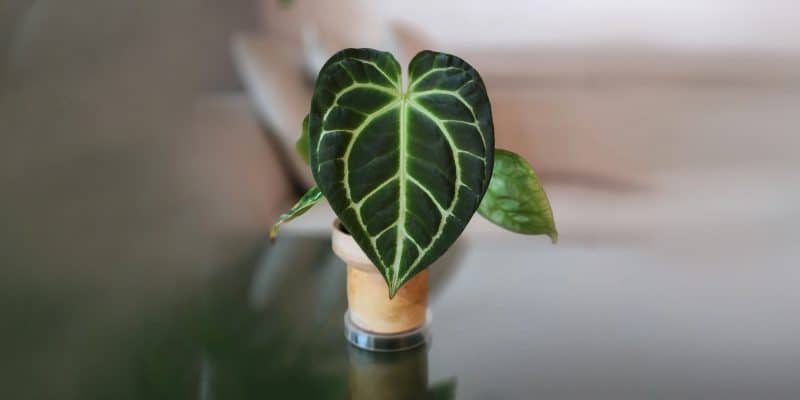Anthurium Magnificum is a remarkable houseplant that features velvety leaves and striking inflorescences. But there’s more than meets the eye with this charmer.
Curious to unravel the secrets to keep your Anthurium Magnificum healthy and thriving?
We’ll delve into everything you need to know about Anthurium Magnificum care — from light and water requirements to temperature, humidity, and soil preferences. Plus, we’ve got expert tips on propagation, repotting, and troubleshooting common issues.
Let’s get started!
Table of Contents
Anthurium Magnificum Plant Care Guide
History, Habitat, and Characteristics
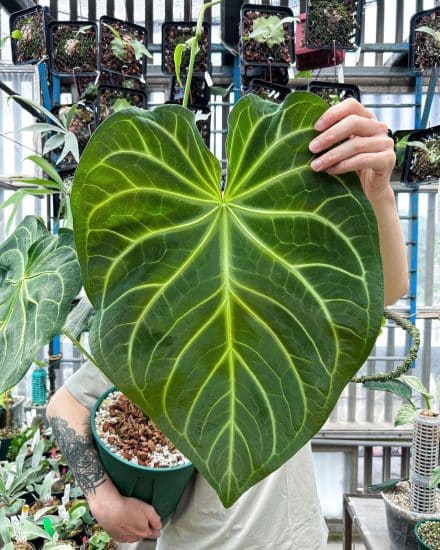
The Anthurium Magnificum plant is known for its delightful foliage. The gorgeous velvety or leathery dark green leaves boast intricate veining, occasionally displaying lighter green hues. With their distinct elephant ear-like shape, this anthurium plant isn’t shy, bringing a bold tropical vibe to any room.
Like other members of the Araceae plant family, Anthurium Magnificum produces peculiar inflorescences. The flowers are clustered together on a spike known as a spathe, and at its base is a colorful waxy spadix that looks like a petal. This unusual structure is a surefire conversation starter, and also explains why this plant is sometimes called the flamingo flower.
Native to the Colombian rainforests, Anthurium Magnificum thrives in the wild as an epiphyte that grows on trees and rocky outcrops. This epiphytic lifestyle is key to replicating its natural environment for a healthy, happy plant at home — think good drainage and stable humidity.
Did you know: There’s a beautiful variety of this plant called Anthurium Magnificum ‘Verde’ with green leaves and less vivid veining, allowing a blue iridescence to shine through.
Light
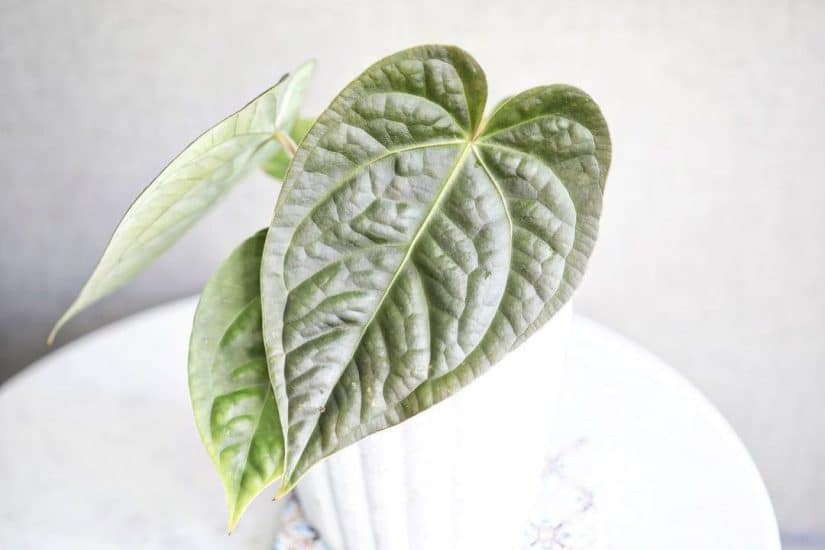
While Anthurium Magnificum plants can cope with some direct light, especially during the morning, direct sun in the heat of the day can cause those beautiful dark green leaves to burn.
To be safe, avoid direct light altogether and offer it a spot near a window where it will receive medium to bright indirect sunlight throughout the day.
If your Anthurium magnificum isn’t receiving enough light, it might become etiolated as it stretches out in search of the sun. Signs of this are longer internodes, elongated petioles, smaller leaves, and stunted growth.
Move it closer to the window, put it in a brighter spot, or try an LED full spectrum grow light to supplement the light it receives.
On the other hand, if you notice burnt or scorched leaves, it’s a clear signal that your anthurium plant is getting too much light.
In this case, try using a sheer curtain to help shield your plant from the sun’s rays, or move it further from the source of direct sunlight.
Lighting tips:
- Provide this tropical plant with medium to bright indirect sunlight throughout the day to avoid etiolation and stunted growth.
- If you can’t find a spot with sufficient indirect sun, try adding an artificial LED grow light.
- Protect your plant’s gorgeous leaves from getting too much sun with a sheer window curtain.
Water
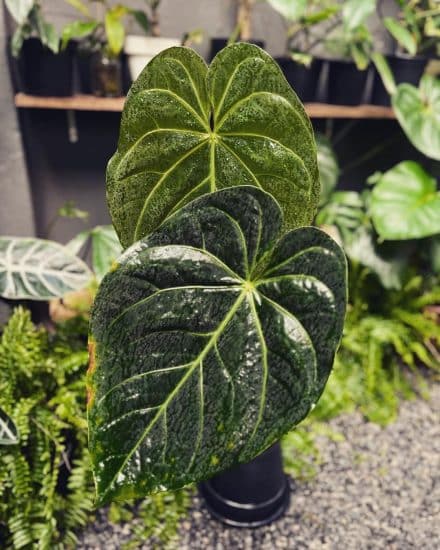
Like many tropical plants, Anthurium Magnificum likes having moist soil that dries out a bit between waterings. When it’s time to give your plant a drink, make sure you soak the soil thoroughly — but also let the extra water drain out through the holes in the bottom of the pot, rather than leaving it to collect at the bottom of a saucer.
To know when to water again, poke your finger about an inch or two into the soil. If it’s still damp, hold off on the watering for a little while longer.
If your Anthurium Magnificum isn’t getting enough water, the older leaves might turn yellow, and the plant could start to wilt. Before you start panicking, just up your watering game a bit and remove any sad-looking leaves to avoid attracting pests.
On the flip side, too much water can cause yellow leaves, mushy stems, and root rot from sitting in soggy soil. If you spot these signs, it’s time to ease up on the H2O and let the soil dry out.
If necessary, change the soil out for a fresh potting mix that offers better drainage.
Temperature and Humidity
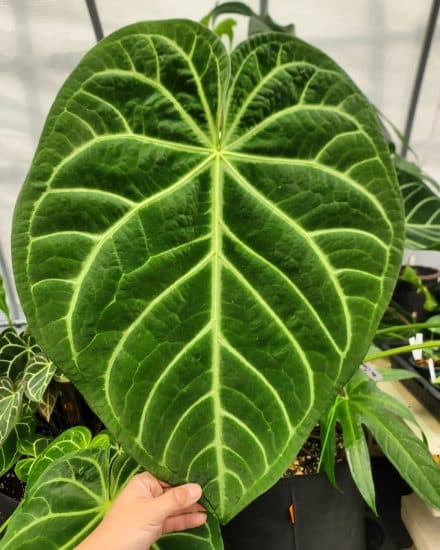
Anthurium Magnificum is a tropical plant that thrives in humid environments and warm temperatures.
Your plant will be happy in household temperatures ranging from 65-80°F (18-27°C). Be sure to keep it away from cold drafts, air conditioning vents, and heaters, which may cause harmful temperature fluctuations.
If you want to take your Anthurium Magnificum plant outside, make sure the temperature is at least 55°F (13°C) to prevent cold-related stress or damage.
This houseplant absolutely loves humidity — the more, the better! Aiming for a humidity level of 60% or above is ideal for your anthurium. High humidity levels not only promote healthy growth but also help keep some common pests, such as spider mites, at bay.
If your plant is getting too little humidity, you may notice the leaves appearing wilted, dry, or developing brown edges. Too much humidity, and you may see mold or signs of rot.
To raise humidity:
- Place a tray filled with water and pebbles underneath your Anthurium Magnificum.
- Use a humidifier to increase the ambient moisture level.
- Group your plant with other humidity-loving tropicals.
- Misting the leaves directly can increase humidity slightly, while also helping to keep the leaves clean and dust-free.
Soil and Planting
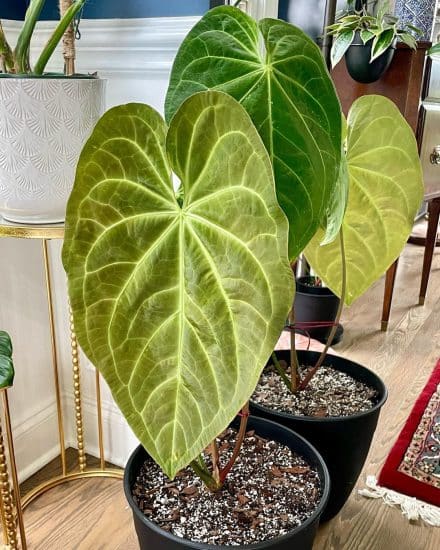
Anthurium Magnificum plants like moisture-retaining soil that drains well, like a combination of sphagnum moss, coco coir, and an aroid potting mix. Adding a layer of moss on top of the soil can also be beneficial in helping to retain moisture.
(Keep in mind that peat moss isn’t the most sustainable choice, so better to opt for something more environmentally friendly like coco coir).
If your Anthurium Magnificum is struggling with poor soil conditions, you may notice sluggish growth, wilting, and yellowing or browning of the leaves. It may also become more susceptible to pests and diseases, as well as root rot if the soil is retaining too much water.
Anthurium Magnificum typically needs to be repotted every 2 to 3 years, depending on how quickly it is growing. Spring is the ideal time to repot, as this is when the plant is in its active growth phase.
When choosing a new pot for your Anthurium Magnificum, select one that’s only slightly larger than the current pot, and be sure it has sufficient drainage holes. Gently remove the plant from its old container, being careful not to damage the delicate roots, and place it in the new pot with a fresh, well-draining soil mix.
While repotting, it’s crucial not to pack the soil too tightly around the root ball, as this can restrict oxygen flow to the plant’s roots and increase the risk of root rot. Instead, gently tamp down the soil to ensure the plant is secure and well-supported in its new home.
Fertilizer
Anthurium Magnificum does best with light fertilization during the growing season. Be mindful not to over-fertilize your plant, as this can lead to problems like burned foliage and root damage. A liquid balanced fertilizer that’s diluted to 50% usually works great, applied no more frequently than once a month.
If you notice that your Anthurium Magnificum plant has yellowing or browning leaves, stunted growth, or an excess of salts on the soil surface, these may be signs of over-fertilizing.
To remedy this situation, cut back on the amount of fertilizer you’re using, and flush the soil with water to help remove any built-up salts.
Propagation
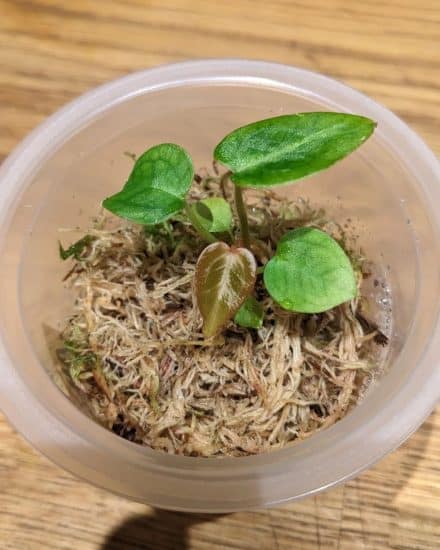
Anthurium Magnificum plants can be propagated by stem cuttings, provided that your parent plant is healthy and growing strong to begin with.
Propagate Anthurium Magnificum via stem cuttings:
- Look for an aerial root: Find a healthy stem section that has an aerial root along with a few leaves and nodes on it.
- Give that root a mossy hug: Gently wrap the aerial root with damp sphagnum moss. This mossy environment will encourage the root system to develop.
- Wrap it up: Grab some plastic wrap and cut a piece big enough to cover the moss-surrounded root. This will help to seal in moisture to create a mini greenhouse effect. Keep it all together with twine or twist ties.
- Wait for the magic to happen: Find a cozy spot that’s warm and humid, with plenty of indirect sunlight for your plant. It’ll take a few weeks for the roots to develop inside the moss. Check in on them now and then to make sure the moss stays damp.
- Time to cut the stem: Once you spot new roots sprouting within the sphagnum moss, use a sterilized knife or gardening shears to carefully cut the stem below the newly rooted section. This is where things get exciting!
- Welcome your new plant baby: Remove the plastic wrap but let the moss stick around the roots. Gently move the stem cutting to its new pot and plant it into a well-draining potting mix. Take good care of your young Anthurium Magnificum and watch it grow.
Common Issues
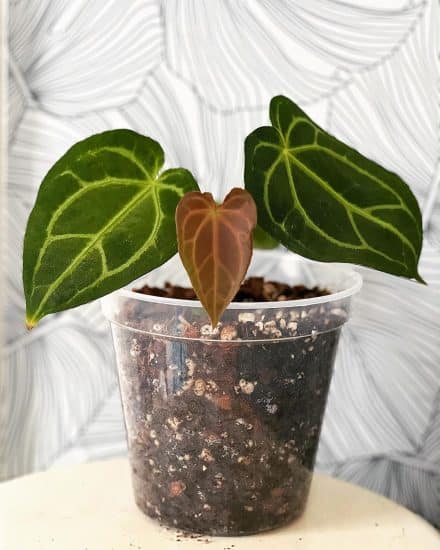
Like with other indoor plants, Anthurium Magnificum’s beautiful dark green leaves can fall prey to leaf spot or start turning yellow. But common problems have common solutions, so we’ll get into how to identify the issue and fix it fast.
Leaf Spots
Anthurium Magnificum leaves can develop spots or other markings for a number of reasons. Brown spots might be because of sunburn, excessive fertilizer, or pest damage, while bacterial or fungal infections can result in spots with yellow circles around them.
If you see suspicious spots on your plant, try to determine the cause. If you suspect they’re from pests or bacteria, try applying neem oil on the leaves. If the source is a fungal infection, you might want to treat your plant with a fungicide — just be sure to follow the manufacturer’s directions.
Yellow Leaves
Yellow leaves could mean a bunch of things for anthurium plants, including improper lighting, too much water, or not enough nutrients. Check out the location and the overall look of those yellowing leaves to get a clue.
Not enough light? Move your green buddy to a brighter spot with bright indirect light. Overwatering? Make sure to let the soil dry a bit before giving it more water and pay attention to proper drainage to prevent waterlogging. Nutrient deficiency? A balanced, slow-release fertilizer might just do the trick.
Pests and Diseases
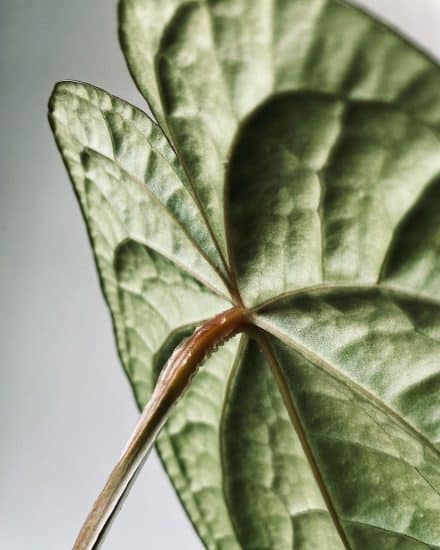
Spider Mites
You might not see them directly, since they’re super small, but if you spot little web-like structures or speckling on the leaves, your Anthurium Magnificum likely has spider mites.
To give those mites the boot, start by gently wiping down the affected leaves and stems with a damp cloth. Then, give your plant a nice neem oil treatment, making sure you cover every nook and cranny, including the underside of the leaves. Do this every week until your plant is back to its gorgeous self.
As for keeping those pesky spider mites away in the future, well, they’re not fans of humidity. So, try using a humidifier or pebble tray to increase the humidity levels around your plant.
Root Rot
Typically, it’s overwatering or poor drainage that causes this issue, which leads to sad, decaying roots.
If you notice yellowing or wilting leaves along with a funky smell coming from the soil, you may have a case of root rot. This can be confirmed by carefully taking the plant out of its pot and checking for black, mushy roots.
If you find them, snip those rotten roots away using sterilized scissors or gardening shears.
Give your plant a fresh start with some well-draining soil, and make sure the pot has proper drainage holes. In the future, be sure to let the soil dry out a bit more between waterings.
Conclusion
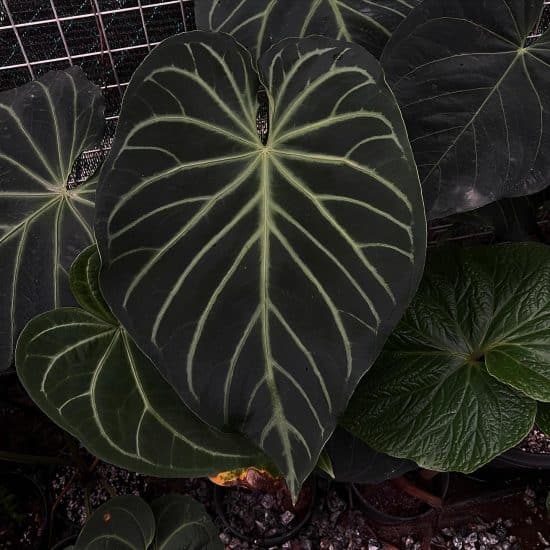
That’s it for our Anthurium Magnificum care guide! You’re now well-equipped with the knowledge you need to keep your stunning plant healthy and thriving.
Anthurium Magnificum care summary:
- Provide medium to bright indirect light, avoiding direct sunlight to prevent leaf burn.
- Water thoroughly, allowing the soil to dry out slightly between waterings, and ensure proper drainage to prevent root rot.
- Maintain household temperatures between 65-80°F (18-27°C) and aim for humidity levels of 60% or above.
- Use well-draining soil that retains moisture, and fertilize lightly with a balanced, slow-release fertilizer when your plant is actively growing.
- Repot every 2-3 years and propagate via stem cuttings.
We hope this guide has helped you become a confident Anthurium Magnificum caretaker. If you have any questions or need further information, don’t hesitate to reach out.
Remember to share this guide with fellow plant lovers and spread the love for this fabulous tropical houseplant.
Take care, and happy planting!
FAQ
Is Anthurium Magnificum rare?
In the wild, Anthurium Magnificum is considered near threatened. In cultivation, it’s also somewhat rare in comparison to more common houseplants. This tropical beauty is certainly less easily found in your average grocery store or garden center than, say, a pothos or snake plant.
That being said, you can still find Anthurium Magnificum at specialty nurseries and online plant shops.
What’s the difference between Anthurium Magnificum and Anthurium crystallinum?
Many anthurium plants share similarities, coming from the same plant family and genus. In the case of Anthurium Magnificum and Anthurium crystallinum, here are some of the key differences that help to set them apart.
Anthurium Magnificum has leaves with a velvety or leathery texture and rounder shape that are relatively wide and can reach up to 3 feet in length. In contrast, Anthurium crystallinum leaves are usually more elongated and heart-shaped, and typically range from 5 to 12 inches long.
The leaves of both plants have intricate veining, but the vein pattern on Anthurium Magnificum is usually lighter green and less prominent than the striking silvery-white veins found on the leaves of Anthurium crystallinum.
Anthurium Magnificum also generally grows larger than Anthurium crystallinum, with a bolder, more robust overall appearance.
Choose your favorite, or better yet, add both to your collection and create an Anthurium wonderland!

